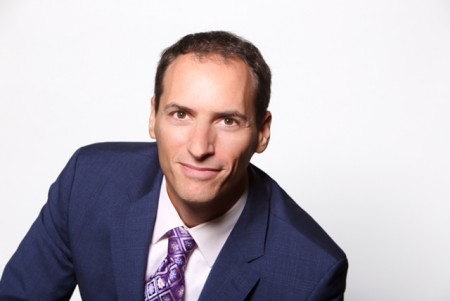Navigating a new era of virtual events during the COVID-19 pandemic

Ari Kaplan. Photo by Lauren Hillary.
Ari Kaplan recently spoke with Matt Homann, the founder of Filament, a company that designs and facilitates virtual and in-person meetings, about how to navigate virtual events during the novel coronavirus crisis.
Ari Kaplan: Tell us about your background and the genesis of Filament.
Matt Homann: I am a recovering lawyer and was an early blogger writing about innovation, creativity and client service. Almost 20 years ago, I remember sitting with peers after a traditional conference at 3 in the morning and we were having the best conversation about the future of law practice, among other topics that were not on the agenda. I asked whether we could create a similar experience a built LexThink, an invitation-only conference designed for small group conversation and collaboration. If I had to pinpoint a single moment in my career that changed everything, that was the beginning of a long journey of facilitating conversations. I moved from there into creative consulting, using visuals to help people think differently about how they collaborate and engage, including for law firm retreats and legal technology events, among others. When I look back, it seems pretty straightforward, but along the way, it was a jumbled mess of a terrified spaghetti.
Ari Kaplan: Why do people attend in-person events?
Matt Homann: Why they attend them and why the organizers think they attend them are two different things. I think organizers tend to believe that we need to have an event to teach people things. While that may have been true 15 or 20 years ago because it was the only place to get curated content about an industry that was fresher than a recent book, the rise of social media has given me access to all of that information. If I want to know what an author is thinking about, I can follow them on Twitter or read their blog. If I want to know what they had for lunch, I can follow them on Instagram. Even if I want to know how they think deeply about key issues in what might have been a traditional panel, you now have podcasts like this one. People have historically attended meetings or conferences for two reasons: insight and connection. Since insight is now available on demand for free almost everywhere, we have leaned more on connection. I think we go to conferences now to engage with peers who have similar challenges, and yet most conferences are built for information delivery, rather than insight discovery or serendipity. That will be a significant challenge moving forward.
Ari Kaplan: What’s the difference between a memorable event experience and one that is forgettable?
 Matt Homann.
Matt Homann.
Matt Homann: It is different for everybody. I don’t know how many people look back with fondness at the tote bag they got when they checked in for a program or the thumb drive full of presentations they received. What’s memorable are the people they meet. For me, the ABA Techshow is probably the most meaningful conference, as it was where I met my first tribe of charismatic deviants who were thinking differently about technology. We were talking about paperless offices 25 years ago. The memory of a conference isn’t the content it contains but the people I engage with, the problems I solve, and the tribe that I build that not only lasts while I’m there but that continues on past the conference. I go back the next year to see them again.
Ari Kaplan: Can you replicate that memorable experience online?
Matt Homann: You can a little bit. We had become collaborative creatures online before this crisis in bits and pieces. Now, it requires more intention because for so many conferences and meetings, that connection happened accidentally. It happened in the hallways. It certainly doesn’t happen when you’re sitting shoulder to shoulder facing the same direction, watching someone read from PowerPoint slides. Even if you think about the traditional networking reception at most events, music was blaring, alcohol was flowing, and it was really uncomfortable for introverts. The real question is: How might you be far more intentional about building the hallway or the engagement time? Sometimes that happens in small breakout groups or by collaborating asynchronously after the event ends. It might be pushing challenges out to participants and giving them different ways to consume the information with others. Those are all things that you can do in person, but not very many people do so. We are effectively a PowerPoint-free meeting business. We build small group collaboration. We focus on getting smart people to think together better, all of which can be done online. It just takes a bit more effort and more attention from the attendees.
Ari Kaplan: How would you characterize the Filament experience?
Matt Homann: Until this crisis, our fundamental working theory of events was to do them in person. We want people to collaborate and engage in small groups using tools, exercises, challenges and worksheets to get them to focus together, right? That harnesses the wisdom of the room and makes it safe for introverts to engage. As a result, at Filament, we have been really successful at building those in-person engagements, and they scale quite well. You can do that in a thousand-person ballroom, as long as the tables are round and not too big. A handful of tools also really support that effort online, such as Zoom breakout rooms or something as simple as a Google slide with a worksheet on it to allow people to dive in and collaborate immediately. We have also been using MURAL, which is fundamentally a big poster board with room for Post-it Notes. If you know that people are coming to an event and engaging virtually, it is less about managing the tools and more about managing their attention. We have a limited amount of attention we can pay online in these days. We have kids around, lesson plans that still need to be worked on with teachers, and dogs barking among many other distractions. When people are in a room together, they feed on the energy and its consistently builds, so you can manage them for eight or even 10 hours at once. Online, you have to think about how to complete each slice of work in 90 minutes and then offer a break until the next day, coupled with collaboration spaces where people don’t all have to be present at once and can continue to live their lives and engage with the rest of the world. If you’re creating an eight-hour event online and expecting people to log on and stay there all day, you will be disappointed because while their browser might be open, they are doing a million other things.
Ari Kaplan: What recommendations do you have for law firms, legal tech companies and others who need to move their events into a virtual environment?
Matt Homann: Stop thinking about translating an in-person event to one that is online. We’ve seen this with meetings in general. In-person meetings are generally pretty terrible and are not often well run. Some lack agendas, and people are disengaged. For the first six weeks of this crisis, we tried to convert in-person meetings into online versions of the exact same thing. That is a risk for conference organizers. We need to ask what we want to deliver to our attendees that they can’t get if they don’t attend this conference and then offer unique ways to deliver it. We now have Zoom fatigue, but the bar for what attendees expect from online events is not being driven by the technology; it is simply the result of boredom with the status quo. Since we are looking at the same screen and using the same tools for every meeting we do, the bar is moving faster and is impacted by how you position the program experience as something different versus just the technology you think about using.
Ari Kaplan: Is there anything you prefer about a virtual event over an in-person experience?
Matt Homann: The pivot to virtual meetings gives you another set of problems to solve and new ways to engage your audience. You can really reset after each online session to make sure that the next one is exactly right for what the group needs. It requires a lot more work, but it gives you more opportunity to customize and engage with your audience to provide exactly what they need versus what you thought they needed at the beginning of the day. The amount of work you can do in virtual setting in the same number of hours that might be spread out over days feels like 50% to 75% more because you can encourage attendees to think and engage on their own.
Ari Kaplan: How do you see legal events evolving?
Matt Homann: I love legal events, but I see about half of them continuing to exist. They have been behind the curve, with some exceptions, and many of them have not changed in 10 years ago. The formats are different and the projectors have gotten smaller, but nearly everything is exactly the same. The pivot to virtual is really difficult, and a lot of them are not going to make it beyond this first version. And, when we can return in person, some will realize that they didn’t need to come after all or will certainly receive more pushback on their budgets. That said, it gives people who really want to innovate not only the permission but the imperative to do so. This is the chance to finally do some of those things that you’ve always wanted to do. Success has kept us from trying to change things too quickly, and now there is a massive opportunity for a handful of people to come out of this a thousand times better than they are today. If you want to innovate and think differently about events, now is the time. You’ll never have more engagement from people who are looking to do something new.
Listen to the complete interview at Reinventing Professionals.
Ari Kaplan regularly interviews leaders in the legal industry and in the broader professional services community to share perspective, highlight transformative change and introduce new technology at his blog and on iTunes.



